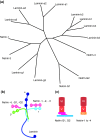The netrin protein family
- PMID: 19785719
- PMCID: PMC2768972
- DOI: 10.1186/gb-2009-10-9-239
The netrin protein family
Abstract
The name netrin is derived from the Sanskrit Netr, meaning 'guide'. Netrins are a family of extracellular proteins that direct cell and axon migration during embryogenesis. Three secreted netrins (netrins 1, 3 and 4), and two glycosylphosphatidylinositol (GPI)-anchored membrane proteins, netrins G1 and G2, have been identified in mammals. The secreted netrins are bifunctional, acting as attractants for some cell types and repellents for others. Receptors for the secreted netrins include the Deleted in Colorectal Cancer (DCC) family, the Down's syndrome cell adhesion molecule (DSCAM), and the UNC-5 homolog family: Unc5A, B, C and D in mammals. Netrin Gs do not appear to interact with these receptors, but regulate synaptic interactions between neurons by binding to the transmembrane netrin G ligands NGL1 and 2. The chemotropic function of secreted netrins has been best characterized with regard to axon guidance during the development of the nervous system. Extending axons are tipped by a flattened, membranous structure called the growth cone. Multiple extracellular guidance cues direct axonal growth cones to their ultimate targets where synapses form. Such cues can be locally derived (short-range), or can be secreted diffusible cues that allow target cells to signal axons from a distance (long-range). The secreted netrins function as short-range and long-range guidance cues in different circumstances. In addition to directing cell migration, functional roles for netrins have been identified in the regulation of cell adhesion, the maturation of cell morphology, cell survival and tumorigenesis.
Figures


References
-
- Gan WB, Wong VY, Phillips A, Ma C, Gershon TR, Macagno ER. Cellular expression of a leech netrin suggests roles in the formation of longitudinal nerve tracts and in regional innervation of peripheral targets. J Neurobiol. 1999;40:103–115. doi: 10.1002/(SICI)1097-4695(199907)40:1<103::AID-NEU9>3.0.CO;2-5. - DOI - PubMed
Publication types
MeSH terms
Substances
LinkOut - more resources
Full Text Sources
Other Literature Sources

